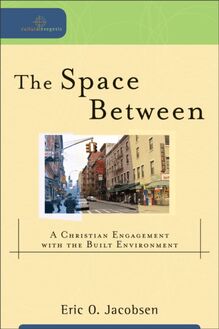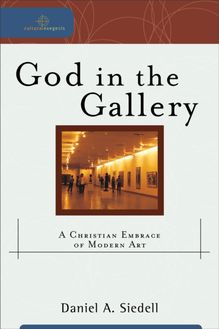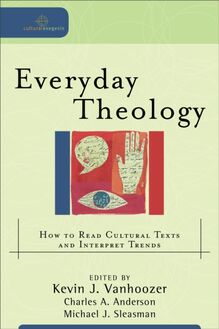God in the Gallery (Cultural Exegesis) , livre ebook
111
pages
English
Ebooks
2008
Vous pourrez modifier la taille du texte de cet ouvrage
Obtenez un accès à la bibliothèque pour le consulter en ligne En savoir plus
Découvre YouScribe en t'inscrivant gratuitement
Découvre YouScribe en t'inscrivant gratuitement
111
pages
English
Ebooks
2008
Vous pourrez modifier la taille du texte de cet ouvrage
Obtenez un accès à la bibliothèque pour le consulter en ligne En savoir plus
Publié par
Date de parution
01 octobre 2008
Nombre de lectures
1
EAN13
9781441201850
Langue
English
Publié par
Date de parution
01 octobre 2008
Nombre de lectures
1
EAN13
9781441201850
Langue
English
In these beautifully crafted essays, Siedell brings the eye of the curator, the intellect of the critic, and the passion of the believer to a much-misunderstood subject. The reader is rewarded with a clear, sharply critical, theologically astute, and decisive apologia for the essential contribution of contemporary art to the life of faith.
-Robin Jensen , Luce Chancellor s Professor of the History of Christian Art and Worship, Vanderbilt University Divinity School
We ve been waiting for this book for nearly forty years. Finally, a robust and unapologetically Christian engagement with contemporary art by an insider to its world and conversation. Though Siedell invites us beyond the wooden ideal of the Christian artist, at the same time he articulates a vision of artistic practice and criticism rooted in the church. He provides much-needed wisdom, modeling how Christians can charitably engage modern art. He also provides much-needed guidance for how Protestants can-and should-incorporate the arts in worship beyond the eclectic pastiche of the hip. Required reading for emerging artists-and their teachers.
-James K. A. Smith , associate professor of philosophy, Calvin College; author of Who s Afraid of Postmodernism?
Finally! A book for contemporary Protestant communities that drinks deeply from the christological dogmas that arose out of the Byzantine iconoclastic controversy (eighth and ninth centuries). In a masterful way, Siedell shows the contemporary relevance of Nicaea II (AD 787) for modern artists and the worship practices of Western Christianity. Readers will discover an iconic worldview that is simultaneously incarnational, sacramental, and transcendent. More than a book, it is an event that celebrates the universal and timeless relevance of Orthodox icons for the twenty-first-century church-East and West.
-Bradley Nassif , professor of biblical and theological studies, North Park University
William A. Dyrness and Robert K. Johnston, series editors
The Cultural Exegesis series is designed to complement the Engaging Culture series by providing methodological and foundational studies that address the way to engage culture theologically. Each volume works within a specific cultural discipline, illustrating and embodying the theory behind cultural engagement. By providing the appropriate tools, these books equip the reader to engage and interpret the surrounding culture responsibly.
God in the Gallery
A Christian Embrace of Modern Art
Daniel A. Siedell
2008 by Daniel A. Siedell
Published by Baker Academic a division of Baker Publishing Group P.O. Box 6287, Grand Rapids, MI 49516-6287 www.bakeracademic.com
Printed in the United States of America
All rights reserved. No part of this publication may be reproduced, stored in a retrieval system, or transmitted in any form or by any means-for example, electronic, photocopy, recording-without the prior written permission of the publisher. The only exception is brief quotations in printed reviews.
Library of Congress Cataloging-in-Publication Data
Siedell, Daniel A., 1966- God in the gallery : a Christian embrace of modern art / Daniel A. Siedell. p. cm. - (Cultural exegesis) Includes bibliographical references (p. ). ISBN 978-0-8010-3184-7 (pbk.) 1. Christianity and art. 2. Modernism (Art) I. Title. BR115.8S57 2008 261.57-dc22
2008012698
Scripture quotations are from the HOLY BIBLE, NEW INTERNATIONAL VERSION . NIV . Copyright 1973, 1978, 1984 by International Bible Society. Used by permission of Zondervan. All rights reserved.
Contents
Preface
Introduction
1. Overture
2. A History of Modern Art
3. Enrique Mart nez Celaya s Thing and Deception : The Artistic Practice of Belief
4. Embodying Transcendence: Material Spirituality in Contemporary Art
5. Art Criticism
6. Art, Liturgy, and the Church
Conclusion: The Search for Christian Art and the Christian Artist
Notes
Preface
This project has two beginnings a decade apart. As a doctoral student studying modern and contemporary art in 1994, I happened across my father s copy of Francis Schaeffer s booklet Art and the Bible . I was no stranger to Schaeffer. My father s library was well stocked with Schaeffer s books, as well as those of C. S. Lewis, Carl Henry, and many others who were instrumental in leading a generation of conservative Protestant Christians out of fundamentalist cultural separatism. Although I had read Schaeffer s How Shall We Then Live? as a teenager, it had been several years since I had read his observations on art, particularly modern art. And now, in the midst of my doctoral studies, it appeared very narrow and limited.
I had been living in and with modern and contemporary art, criticism, and theory for several intense years, having already written a master s thesis on the critics of abstract expressionist Willem de Kooning under the direction of an active and high-profile critic, Donald B. Kuspit at Stony Brook, and was in the process of developing the contours of my doctoral dissertation on abstract expressionism under the guidance of Stephen C. Foster at the University of Iowa. I felt that Schaeffer s observations and conclusions betrayed a lack of interest in the subject and a too-easy inclination to move from art to philosophy, from artifact to explanation, from complex work of art to simple worldview. For Schaeffer, modern art was merely a visual illustration of a secular worldview philosophy, be it existentialism, nihilism, or humanism.
My discovery of Reformed evangelical Christian scholarship, initiated through Mark Noll s The Scandal of the Evangelical Mind (1994), was seminal in my development of a response to Schaeffer. It caused me to rethink the implications of my faith and its relevance to my intellectual vocation, which I had not considered as seriously at that time as I could have. It started me on an intellectual (and spiritual) journey that I could not have foreseen and on which I now continue. This book is thus an end and a beginning. It marks my response to Schaeffer, not only about modern art but also about vocation and, ultimately, discipleship in the world of contemporary art. It is also a beginning, as this book sketches the contours of future scholarship.
The second beginning occurred in 2004 after I read William Dyrness s Visual Faith , a book in Baker Academic s Engaging Culture series that explores the role of visual art in the contemporary church. Having long since completed my doctoral dissertation and having developed a career as a curator of modern and contemporary art at a university art museum, I wrote a review essay that addressed what I felt to be Dyrness s lack of attention to the history and theory of modern and contemporary art. 1 After I sent him a copy of my review, Bill encouraged and challenged me to pursue my line of reasoning in a book. Meetings at CIVA (Christians in the Visual Arts) conferences, talks at Fuller, and participation in his Visual Art and the Practice of Christian Worship seminar at Calvin College in the summer of 2006 further developed this book and nourished our relationship, which is continuing with a collaborative project on an alternative history of modern art.
Visual Faith begins with a specific issue- worship and the arts in the church-and touches only slightly on modern and contemporary art. In fact, Dyrness admits that his book could have taken different directions: one might spend more time focusing on the secular art world, discussing ways in which God is present and at work there. 2 This book is just such an attempt. It begins unapologetically in the world of contemporary art. Thus Visual Faith and the present study face each other, in dialogue. This book would not have been possible without Visual Faith and Bill s encouragement.
This book bears the imprint of my work as a curator at the Sheldon Art Gallery at the University of Nebraska-Lincoln for the past ten years, working with an impressive permanent collection of modern and contemporary American art, developing relationships with a vast array of contemporary artists on curatorial projects, and speaking about contemporary art to a variety of different-and sometimes skeptical-audiences. In addition, much of this material has been taught in various classroom contexts to undergraduate and graduate studio art students at the University of Nebraska-Lincoln and to art students in a course on spirituality and contemporary art at Concordia University in Seward, Nebraska.
This book is for those who want a different image of modern and contemporary art to contemplate. It does not displace existing books on the subject; it is intended to be read in conjunction with them, including Schaeffer s Art and the Bible . This book is for undergraduate or graduate art students who want to bring their faith into a deeper relationship with their own artistic practice and who have not found compelling voices in Christian literature; it is for philosophers or theologians who want a more nuanced treatment of modern and contemporary art to flesh out their understanding of cultural practice or those theologians for whom aesthetics play a preeminent role; it is for missional church leaders, emergent or otherwise, who are reflecting on the role of the visual arts in the postmodern church.
I am indebted to David Morgan, whose scholarship has been influential and who has been a stable source of encouragement. He is the scholar and teacher I aspire to be like. I hope this book begins to repay the time and effort he has invested in my work over the years.
This book also bears the influence of Enrique Mart nez Celaya, whose art and life have had a decisive impact on my practice as a curator, critic, and Christian. Most art critics experience the landscape of contemporary art through the lens of an artist who amplifies and focuses attention. Mart nez Celaya is my lens.
John Wilson, editor of Books Culture , has long been an advocate and supporter of m






